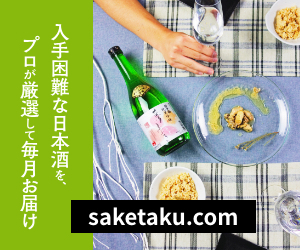- Home
- Sake
- Junmai-Dai-Ginjo Gyakuten Sayonara Manrui Home run
Junmai-Dai-Ginjo Gyakuten Sayonara Manrui Home run(Akita)
| Specially designated name | Junmai-Daiginjo-shu | |
|---|---|---|
| Type | ||
| Material Rice | Miyama-nishiki | |
| Polishing ratio | 50% | |
| Alcohol | 15度 | |
| Sake meter value | +1 | |
| Acid Level | 1.5 | |
| Amino Level | ||
| Rich / Light | ||
| Dry / Sweet | ||
| Taste Type |
| Specially designated name | Junmai-Daiginjo-shu |
|---|---|
| Type | |
| Material Rice | Miyama-nishiki |
| Polishing ratio | 50% |
| Alcohol | 15度 |
| Sake meter value | +1 |
| Acid Level | 1.5 |
| Amino Level | |
| Rich / Light | |
| Dry / Sweet | |
| Taste Type |
| Brewed by | Yamamoto General Partnership |
|---|---|
| Production | Akita |
| Brewing Method | |
| Sake Yeast | |
| Recommended temperature | cold |
Product Description
Sake Search Review
Yamamoto Gomei Kaisha, which is well-known as the producer of famous brands, “Shirataki” and “Yamamoto”, makes “Junmai Daiginjoshu Gyakuten Sayonara Manrui Home-run.” It is paired with “Two Out Full Base.” The gift boxes are full of character. The color of the box for Two Out Full Base is blue, while the other is red. Why the colors are chosen, is that Two Out Full Base meaning “bases loaded with two outs” is a highly nervous situation for your team. So, the blue color represents a negative feeling. In contrast, Sayonara Manrui Home-run meaning “game-ending home run” is full of celebration. The red color indicates an abundance of joy. Besides the colors, they provide useful information on baseball and a different type of scoreboard. With the board, you can play with your friends.
The brewery’s director, Mr Yamamoto hit on the idea while driving his car.
Many locals who live in Happo town of Akita prefecture enjoy baseball, regardless of their age, and also, Mr Yamamoto’s son plays baseball.
One day, he thought: “When people take a bottle of sake with the box to a baseball team for a party or at their training ground, if a sake box shows something related to a baseball game, it could be interesting and will excite the team.”
The brewery has grown organic rice in their field, and produce sakes, using the water that comes from the same water source as their rice field. The staff polish the rice at the brewery where Beatles’ tracks run.
Taste
If you are a Junmai Dai Ginjoshu lover, why not try it with a wine glass? A wine glass’s ability to fully capture and emphasize a wine’s aroma and flavors applies to Japanese sakes. It will intensify the refined fragrance brilliantly.
When I tried, I felt that the taste is contemporary with today’s taste. The delicate flavor spread over my palate. The liveliness and crispness also cut through my nose.
[Food pairing]“Chukadon ” (a bowl of rice with a chop-suey like a mixture with it)
Chukadon’s sauce was starchy, peppery and slightly tangy, which is down to a dash of vinegar and a pinch of black pepper.
When I paired it with Sayonara Manrui Home-run, the Chukadon surprisingly worked well as the flavor was lighter although the sauce looked rich.
The acidity of the vinegar perfectly matches the crispness of the sake.
When I had the second sip, the umami flavor in the ingredients was intensified. It appears that the sake complements the dish, and the sesame oil and black pepper in the sauce gives a nice kick to the gorgeous flavor of the sake.

